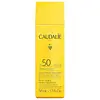What's inside
What's inside
 Key Ingredients
Key Ingredients

 Benefits
Benefits

 Concerns
Concerns

 Ingredients Side-by-side
Ingredients Side-by-side

Water
Skin ConditioningEthylhexyl Methoxycinnamate
UV AbsorberHomosalate
Skin ConditioningMethylene Bis-Benzotriazolyl Tetramethylbutylphenol
UV FilterSilica
AbrasiveDiethylamino Hydroxybenzoyl Hexyl Benzoate
UV FilterC12-15 Alkyl Benzoate
AntimicrobialCetyl Palmitate
EmollientGlycerin
HumectantCaprylic/Capric Triglyceride
MaskingSteareth-21
CleansingCetyl Alcohol
EmollientPhenoxyethanol
PreservativeDecyl Glucoside
CleansingPalmitic Acid
EmollientButylene Glycol
HumectantStearic Acid
CleansingAcrylates/C10-30 Alkyl Acrylate Crosspolymer
Emulsion StabilisingStearalkonium Hectorite
Gel FormingXanthan Gum
EmulsifyingSodium Hydroxide
BufferingPolyglyceryl-3 Diisostearate
EmulsifyingPolyglyceryl-3 Polyricinoleate
EmulsifyingFarnesol
PerfumingEthylhexylglycerin
Skin ConditioningDisodium EDTA
Propylene Glycol
HumectantCentella Asiatica Extract
CleansingPolygonum Cuspidatum Root Extract
AntioxidantScutellaria Baicalensis Root Extract
AstringentCamellia Sinensis Leaf Extract
AntimicrobialGlycyrrhiza Glabra Root Extract
BleachingChamomilla Recutita Flower Extract
MaskingRosmarinus Officinalis Leaf Extract
AntimicrobialLinalool
PerfumingHydrolyzed Rhodophyceae Extract
Water, Ethylhexyl Methoxycinnamate, Homosalate, Methylene Bis-Benzotriazolyl Tetramethylbutylphenol, Silica, Diethylamino Hydroxybenzoyl Hexyl Benzoate, C12-15 Alkyl Benzoate, Cetyl Palmitate, Glycerin, Caprylic/Capric Triglyceride, Steareth-21, Cetyl Alcohol, Phenoxyethanol, Decyl Glucoside, Palmitic Acid, Butylene Glycol, Stearic Acid, Acrylates/C10-30 Alkyl Acrylate Crosspolymer, Stearalkonium Hectorite, Xanthan Gum, Sodium Hydroxide, Polyglyceryl-3 Diisostearate, Polyglyceryl-3 Polyricinoleate, Farnesol, Ethylhexylglycerin, Disodium EDTA, Propylene Glycol, Centella Asiatica Extract, Polygonum Cuspidatum Root Extract, Scutellaria Baicalensis Root Extract, Camellia Sinensis Leaf Extract, Glycyrrhiza Glabra Root Extract, Chamomilla Recutita Flower Extract, Rosmarinus Officinalis Leaf Extract, Linalool, Hydrolyzed Rhodophyceae Extract
Zinc Oxide 21.1%
Cosmetic ColorantWater
Skin ConditioningCaprylic/Capric Triglyceride
MaskingButyloctyl Salicylate
Skin ConditioningCalcium Sodium Borosilicate
Erythritol
HumectantLauryl Laurate
Skin ConditioningPropanediol
SolventCarthamus Tinctorius Oleosomes
EmollientBentonite
AbsorbentNiacinamide
SmoothingPalmitoyl Grapevine Shoot Extract
AntioxidantCetearyl Alcohol
EmollientCaprylyl Glycol
EmollientEthyl Ferulate
AntioxidantSucrose Polystearate
EmollientHelianthus Annuus Seed Oil
EmollientSucrose Stearate
EmollientCoco-Glucoside
CleansingBisabolol
MaskingCitric Acid
BufferingCaramel
Cosmetic ColorantPolyhydroxystearic Acid
EmulsifyingPongamia Pinnata Seed Extract
Skin ConditioningSodium Gluconate
Skin ConditioningCaprylhydroxamic Acid
Glycerin
HumectantTocopherol
AntioxidantMicrocrystalline Cellulose
AbsorbentBeta-Sitosterol
Emulsion StabilisingGluconolactone
Skin ConditioningSqualene
EmollientXanthan Gum
EmulsifyingAloe Barbadensis Leaf Juice Powder
Skin ConditioningSodium Benzoate
MaskingZinc Oxide 21.1%, Water, Caprylic/Capric Triglyceride, Butyloctyl Salicylate, Calcium Sodium Borosilicate, Erythritol, Lauryl Laurate, Propanediol, Carthamus Tinctorius Oleosomes, Bentonite, Niacinamide, Palmitoyl Grapevine Shoot Extract, Cetearyl Alcohol, Caprylyl Glycol, Ethyl Ferulate, Sucrose Polystearate, Helianthus Annuus Seed Oil, Sucrose Stearate, Coco-Glucoside, Bisabolol, Citric Acid, Caramel, Polyhydroxystearic Acid, Pongamia Pinnata Seed Extract, Sodium Gluconate, Caprylhydroxamic Acid, Glycerin, Tocopherol, Microcrystalline Cellulose, Beta-Sitosterol, Gluconolactone, Squalene, Xanthan Gum, Aloe Barbadensis Leaf Juice Powder, Sodium Benzoate
 Reviews
Reviews

Ingredients Explained
These ingredients are found in both products.
Ingredients higher up in an ingredient list are typically present in a larger amount.
This ingredient is an emollient, solvent, and texture enhancer. It is considered a skin-softener by helping the skin prevent moisture loss.
It helps thicken a product's formula and makes it easier to spread by dissolving clumping compounds.
Caprylic Triglyceride is made by combining glycerin with coconut oil, forming a clear liquid.
While there is an assumption Caprylic Triglyceride can clog pores due to it being derived from coconut oil, there is no research supporting this.
Learn more about Caprylic/Capric TriglycerideGlycerin is already naturally found in your skin. It helps moisturize and protect your skin.
A study from 2016 found glycerin to be more effective as a humectant than AHAs and hyaluronic acid.
As a humectant, it helps the skin stay hydrated by pulling moisture to your skin. The low molecular weight of glycerin allows it to pull moisture into the deeper layers of your skin.
Hydrated skin improves your skin barrier; Your skin barrier helps protect against irritants and bacteria.
Glycerin has also been found to have antimicrobial and antiviral properties. Due to these properties, glycerin is often used in wound and burn treatments.
In cosmetics, glycerin is usually derived from plants such as soybean or palm. However, it can also be sourced from animals, such as tallow or animal fat.
This ingredient is organic, colorless, odorless, and non-toxic.
Glycerin is the name for this ingredient in American English. British English uses Glycerol/Glycerine.
Learn more about GlycerinWater. It's the most common cosmetic ingredient of all. You'll usually see it at the top of ingredient lists, meaning that it makes up the largest part of the product.
So why is it so popular? Water most often acts as a solvent - this means that it helps dissolve other ingredients into the formulation.
You'll also recognize water as that liquid we all need to stay alive. If you see this, drink a glass of water. Stay hydrated!
Learn more about WaterXanthan gum is used as a stabilizer and thickener within cosmetic products. It helps give products a sticky, thick feeling - preventing them from being too runny.
On the technical side of things, xanthan gum is a polysaccharide - a combination consisting of multiple sugar molecules bonded together.
Xanthan gum is a pretty common and great ingredient. It is a natural, non-toxic, non-irritating ingredient that is also commonly used in food products.
Learn more about Xanthan Gum